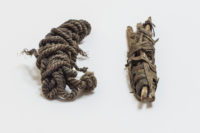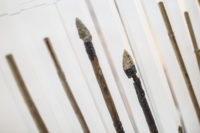 Ötzi the Iceman, the 5,300-year-old Neolithic glacier mummy discovered by hikers in the Otztal Alps in 1991, has set another record: he is the owner of the oldest known bowstring in the world. In fact, Ötzi’s whole kit — quiver, arrows, bowstring and unfinished bow — is the oldest hunting equipment in the world.
Ötzi the Iceman, the 5,300-year-old Neolithic glacier mummy discovered by hikers in the Otztal Alps in 1991, has set another record: he is the owner of the oldest known bowstring in the world. In fact, Ötzi’s whole kit — quiver, arrows, bowstring and unfinished bow — is the oldest hunting equipment in the world.
Made of three strands of twisted fibers, the cord was found in the quiver. The Iceman had carefully wound it into an S-shaped bundle and tied a knot at the end, not unlike how I store my extension cords. It looks like a hemp rope and experts at the South Tyrol Museum of Archeology where Ötzi and his stuff are kept were not able to determine whether the cord was made of plant or animal fiber. The former would be unusable for a bowstring because they lack the necessary flexibility to withstand the tension of the bow.
Only three examples of Neolithic bowstrings are known to have survived. A study by the Swiss National Science Foundation (SNSF) compared prehistoric bowstrings recovered from alpine glaciers. Using a microscopic fiber sample from the string found in Ötzi’s quiver, the team confirmed that it was made of the leg sinew of an undetermined animal, not from plant fibers, and therefore ideally suited for a bowstring. The cord is almost six-and-a-half feet long, long enough to fit the 5’11”-long yew stave Ötzi had  almost finished fashioning into a bow when he was killed. Stretched out to its full taunt length, the cord, which is 4mm in diameter relaxed, would be 2-3mm in diameter, a perfect fit for the width of the notches in the arrows Ötzi carried. A loosely wound bundle of animal leg sinew was also found in his quiver, perhaps raw material for bowstring production.
almost finished fashioning into a bow when he was killed. Stretched out to its full taunt length, the cord, which is 4mm in diameter relaxed, would be 2-3mm in diameter, a perfect fit for the width of the notches in the arrows Ötzi carried. A loosely wound bundle of animal leg sinew was also found in his quiver, perhaps raw material for bowstring production.
The rest of Ötzi’s gear also lends unique insight into Neolithic hunting practices, touching on a range of subjects from trade to tool use to the kinesiology of the hunt.
Ötzi’s 1.83 m long, unfinished bow made of yew (Taxus baccata) gave a unique, informative glimpse into how Neolithic bows were manufactured. The bow was first freshly cut from an 8-10 cm thick yew tree. He had already made good progress with his work, but the bow probably needed to be shortened and thinned. The best shooting results are obtained when the bow approximately corresponds to the height of the archer. For Ötzi that would have been approximately 1.60m. The investigation was able to establish that Ötzi’s bow had been worked with a hatchet from both directions. Whether this had been done by Ötzi himself cannot be determined. The question of how to work the ends of the bow to fasten the string also remains open. Junkmanns proposed the hypothesis that Ötzi could have purchased the rough bow on the way, which would possibly explain why he had an unfinished bow with him in the high mountains.
Even the Iceman’s quiver is the only known Neolithic carrying case for arrows. It is 86 cm long and stitched from doeskin (Rupicapra rupicapra). One side of the quiver is reinforced with a hazel wood stick. At the upper end of the quiver a flap of stiffened leather protected the arrows carried within. If required, it could be opened very quickly and an arrow could be pulled out with a single motion of the arm.
The quiver’s interior held 14 arrows, two of which were ready to fire and complete with arrowheads and fletching. They represent the best preserved examples of Neolithic arrow production in Europe. Neolithic arrows were most often made from branches of suitable bushes like hazel (Corylus avellana) or, as with Ötzi, from the branches of the wayfaring tree (Viburnum lantana). Three feather halves were attached to the end of Ötzi’s arrows with birch tar glue and bound with thin nettle fibers. They represent the only preserved fletchings in Europe. The three-part, radially-placed fletching for stabilizing the arrow during flight has remained virtually unchanged since the Neolithic.
The SNSF study has been published in the Journal of Neolithic Archaeology and can be read here.

Friends,
This was a fascinating story, particularly for a period longbow archer such as myself.
I was drawn to the photo of Ötzi’s arrows (blow it up by clicking). One clearly shows a detachable short shaft, upon which the point is mounted, that fits into the longer fletch shaft. This would allow the fletched portion to be drawn out from the kill and another point mounted. The short section and point would be recovered during butchering.
Two-part arrows like this were demonstrated by Ishi, the Yahi Native American, in the early 20th century to the archaeologist Theodore Kroeber and the famous archer Dr. Saxton Pope, with whom Ishi hunted.
Yours Aye,
Mungo Napier, Archer of Mallard Lodge (SCA)
(aka Garth Groff)
Garth, intentionally or not, this obviously was, what had happened to poor Ötzi himself:
He was shot, and his murderer then must have turned him over, i.e. in order to “draw out the fletched portion out from the kill” (what also very well explains his weird posture), and it seems as if he was successful in that.
The “butchery”/ autopsy 5300 years later, then found the “short section”, or at least the projectile. It is probably fair to assume that it took a while to make one of the flint projectiles, and they were a likewise valuable piece of equipment.
:hattip:
Thanks both of you for pointing this out and elaborating. I did not notice the detachable shaft at first but now I see it clearly. Wow Otzi’s story gets more interesting each new thing.
Garth –or anybody else– do you have an opinion on the hypothesis that Ötzi’s “unfinished” longbow probably was not so unfinished at all, and to carry the bowstring in the quiver was in fact Neolithic usual alpine business traveler mode?
Are there —as I vaguely remember that human RNA of more than one individual had been detected on his flint knife, a couple of years ago— new insights on how many attackers are identified by now?
Sally,
Livius’ commentary says clearly the bow was unfinished. It was still a bit long for optimal shooting, and needed to be thinned, probably in the center, to spread the draw forces more evenly throughout the stave to prevent breaking. There also was yet to be a way to attach the string.
Medieval yew bows usually had horn limb ends with a string nock cut into each into which a loop of the bowstring was slid when the bow was strung up for shooting (the string was looped at each end using a “bowyer’s knot”, very similar to a “timber hitch”). From the picture you can see there are no such limb ends. The other possibility was to cut the string nock directly into the wood. I inquired about this method with Shawn Webb, the bowyer who made my first two yew longbows. In his opinion this would have weakened the wood, causing the bow to eventually break near the end. Which method was the neolithic bow making method is beyond my experience.
I would like to know more about how the bow was carved. English yew bows gain their great strength from working down the stave so there is a thin layer of yellow sap wood on the belly of the bow (the side facing the intended target). A thicker layer of red heart wood makes up the back of the bow (facing the archer; “back and belly” is an analogy to man bending forward at the waist). Yew sap wood resists tension, or being stretched, which happens since that layer is on the outside of the arc when the bow is drawn. Heart wood resists compression, which happens on the inside of the curve. So a yew bow has two powerful natural springs working in unison. I don’t know if other woods can be worked this way. I own hickory and oak longbows made of single layer of wood, and a “composite” longbow with a layer of oak bonded to a hickory core in imitation of a yew bow. The composite bow was the lightest to draw, but actually shot as well as the heavier oak and hickory one-piece bows. None could even approach the power and speed of my yew bows of similar draw weight.
For the record, all three of my yew bows broke, and sooner than they should have considering the price I paid for them. One exploded, the break right at eye level, though fortunately all the pieces were blown away from my face. A very scary experience though. Yew can be a very brittle wood. Next time osage orange!
Yours Aye,
Mungo
There does not appear to be an active link to the Journal mentioned in the last paragraph. All that is there is a photo of the bow. Can the link be included, please? Or, am I missing something?
Thanks! :boogie:
The article, might be this one here:
Jürgen Junkmanns, Johanna Klügl, Werner H. Schoch, Giovanna Di Pietro, Albert Hafner: “Neolithic and Bronze Age archery equipment from alpine ice-patches: A review on components, construction techniques and functionality”, JNA 21, 2019, pp.283–314 [doi 10.12766/jna.2019.10]
————
Abstract:
“The alpine ice-patch sites of Tisenjoch (I), Schnidejoch and Loetschenpass (CH) brought to light the most complete archery equipment known from European Prehistory. From the end of the last glaciation until the Middle Ages, bows and arrows were the most important weapons for hunting and warfare. The first verified artefacts of archery equipment are the arrows from Stellmoor, Northern Germany, which date to 10,000 BC, while the oldest bows found so far are still the two elm bows from Holmegard in Southern Denmark, dated to ca. 8000–6500 BC (Junkmanns 2013). During the Neolithic, bows were made almost…”
doi.org/10.12766/jna.2019.10:
JUNKMANNS, et al. Neolithic and Bronze Age archery equipment from alpine ice-patches: A review on components, construction techniques and functionality. Journal of Neolithic Archaeology, [S.l.], v. 21, p. 283-314, dec. 2019. ISSN 2197-649X.
Available at: http://www.jna.uni-kiel.de/index.php/jna/article/view/169
:hattip:
Sally,
I’ve been thinking about the bow, and wonder if perhaps there never would have been a separate limb end, or notches cut into the wood. A bowyer’s knot is self-tightening (they are an absolute pain to remove!). It is possible that the loop it was just slipped over the end of the bow, and tightened so that it could only slide down so far as the bow widened out.
One has to be careful not to read too much from better known techniques of the middle ages into something as old as Ötzi’s weapon.
On the other hand, what we don’t see is how thick the stave is. Livius tells us that the investigators say the stave needed to be thinned further, and I can accept this is true. That said, it may be that the bow was shootable in this form and never meant to be thinned further. There just aren’t many other examples of yew bows from this time for comparison.
Yours Aye,
Mungo